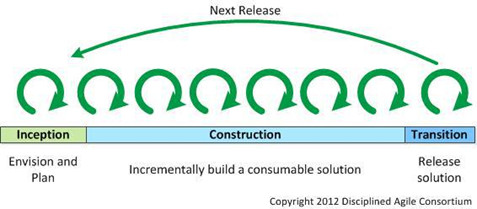What if the Agile project you are launching is a big and complex one?
What if the usual “2 days inception” are not enough to lift-off your project?
I love the Inception Deck from the Agile Samurai.
Yes, I really do love it because is a great set of agile tools you can use to explore the main dimensions of a project, in a completely new way respect to the traditional approaches: collaborative, using visual management and avoiding too much detail but with a great effectiveness.
It happens, however, that the project you are trying to launch, needs more understanding about scope, risks, architecture, etc. but you still want to avoid any big up-front analysis.
Well, DAD could help.
DAD is a hybrid framework that builds upon the solid foundation of other methods and software process frameworks. The framework adopts practices and strategies from existing sources and provides advice for when and how to apply them together.
The product development lifecycle looks like the picture below:
At a first glance, DAD could seem a bit too process-oriented, too structured.
But, actually, DAD incorporates the Agile Manifesto, defines its own Disciplined Agile Values and Principles, is completely geared on the Lean principles and finally is strongly empirical.
DAD Inception Phase
One of the most interesting thing I found in DAD, is the Inception phase (or Iteration 0 or Warm Up).
I usually use that phase with big, complex projects to “manage” with Agile, which needs more information before to proceed with the construction/build phase.
This Inception phase could last from 2 to a maximum of 6 weeks (Ambysoft 2013 Agile Project Initiation Survey Results) and depends on the project nature and size.
The main objectives of the DAD Inception phase are:
- Clarify the needs the project wants to satisfy
- Define a clear project (and product) vision
- Identify a feasible technical solution
- Define the strategy and a high level roadmap
- Build the team and set-up the necessary technical environments
- Involvement and buy-in of the stakeholders
I use to execute this phase using scrum, too.
The organization must identify the Product Owner who will be in charge also for the Construction phase, and a Scrum Master is needed as well to help people remain focused.
Then, the work proceeds by running sprints (one-week length) and sticking to the scrum events in order to plan for the work, keep learning, demonstrate the work done and retrospect the results and the process utilized as well.
Every phase in DAD is divided in three specific moments called: Coordinate, Collaborate, Conclude.
The Coordinate moment provides for the creation of the inception team, a first draft agenda definition for the first week, just to have some guidelines and to involve the right stakeholders since from the beginning.
This agenda, then, will be discussed by the inception team and adjusted according to the real needs once started.
The Collaborate moment is when the learning phase starts and work is actually done.
Here the team is finally built, Scope and Architecture are high level envisioned, any necessary feasibility spike is done, any initial issue, risk or impediment is identified and addressed in order to facilitate the project start-up and a first high level estimation is done to have a range in terms of effort that could be spent for the project.
Then, the Conclude moment, aims to communicate the outcomes of the inception sprints to the relevant stakeholders in order to have their consensus.
I would like to spend just a few words regarding the inception team.
Usually at this point in time of the project, we probably do not have yet available the whole budget for the project. The project, probably, will be definitely confirmed with the information gathered during the Inception.
This means that the Inception team won’t be formed by the whole development team but probably by one or two senior team representatives, an architect, the product owner, and the necessary SME (Subject Matter Expert) that could be called on-demand according to the workshop sessions (high level envisioning of architecture, scope, U.X., DB, etc.) scheduled in this phase.
To summarize, during those sprints, the Inception aims to deliver an high level view of these items:
- Vision
- Program/Project Objectives
- H.L. Roadmap
- First draft Product Backlog version
- H.L. Architecture
- H.L. UX Artifacts
- H.L. Estimation
- Issue Log
What to do next?
Weel, it’s time to bring on board all the team members, have a 1 or 2 days lift-off and finally start to build the system.
Oh yes, obviously using Agile.






